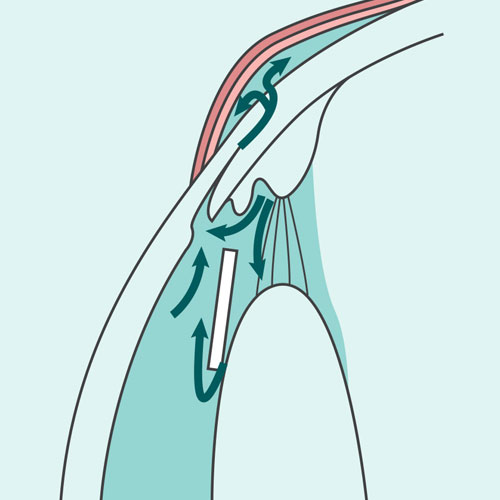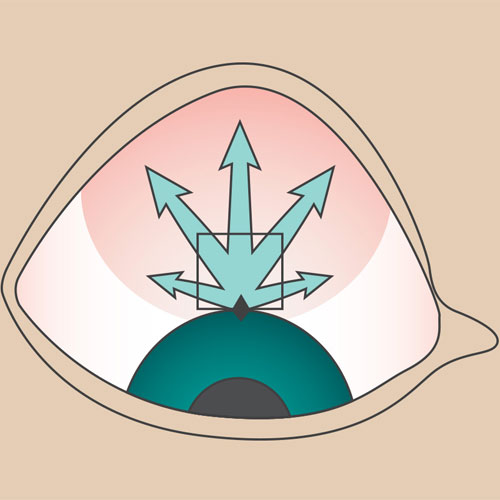Trabeculectomy surgery is generally performed for glaucoma patients who require further lowering of internal eye pressure (intraocular pressure) despite maximal tolerated glaucoma drops and failed laser therapy. The aim of surgery is solely to reduce intraocular pressure, which in turn slows down the progression of peripheral visual field loss caused by glaucoma. It does not improve vision or recover visual fields already lost.
WHAT IS A TRABECULECTOMY?
This procedure creates an alternative drainage channel to help the internal eye fluid (called aqueous humor) to drain out of the eye. This is achieved by fashioning a ‘hole’ in the wall of the eyeball. Through this passage, drainage of aqueous humor is bypassed from the natural drain of the eye (the trabecular meshwork) to a space underneath the conjunctiva (mucous membrane that covers the white of the eye) and forms a ‘bleb’ which is usually covered by the upper eyelid (see figure 1). Because the body naturally reacts to surgery by scarring, which ultimately limits the effect of the procedure, anti-scarring drugs are often applied during surgery to improve the chance of success.

Cross section of the eye showing the new passage of fluid into the bleb.

Showing location of the bleb with eye looking down.
WHAT TO EXPECT AFTER TRABECULECTOMY?
Aftercare of trabeculectomy surgery during the early post-operative period is equally as important as the surgery itself. Patients are usually seen weekly for 4-6 weeks and more frequently if the pressure is too high or too low. During this time, sutures may be adjusted / removed and additional injection of anti-scarring drugs may be required to counteract the body’s natural scarring response. Usual glaucoma drops to the operated eye must be stopped after surgery unless otherwise advised.
It is normal for vision to be blurred for 1-2 weeks following surgery, and then start to improve. It can take 2-3 months for the eye to feel completely back to normal and the vision to stabilise. The eye will also feel ‘gritty’ and uncomfortable for the first few weeks and gradually improve. Strenuous activities should be avoided during the early post-operative period.
SUCCESS RATE
The success rate of trabeculectomy in controlling intraocular pressure varies according to a number of risk factors including the type of glaucoma, previous surgery, race, age and other conditions. Overall, 80-90% of patients are able to achieve optimal pressure control, and most of them without using drops. However up to 10-15% may require further surgery for uncontrolled pressure. The effect of the surgery may also reduce over the years.
COMPLICATION AND SIDE EFFECT
All surgery has some risks, and any operation is not done unless the chance of benefit outweighs the risk. For trabeculectomy, the risk of severe complications causing irreversible loss of vision is very low (1 in 1000). These include infection and expulsive haemorrhage. More common minor complications include: transient low pressure or failure requiring further surgery, transient minor bleeding, formation of cataract, drooping of eye lid, slight reduced vision, change in glasses prescription.
ACTIVITIES AFTER TRABECULECTOMY SURGERY
Following surgery you are able to read and watch television as normal as these activities will not harm your eye. It is important, however, to avoid strenuous activity during the first few weeks after surgery. The following table is a general guide but may be altered depending upon how each individual’s eye recovers.
| ACTIVITY | RESTRICTIONS |
|---|---|
| Hair washing | No need to avoid but back wash advised to avoid getting shampoo into the eye for the first few days. |
| Showering and bathing | No need to avoid but don’t allow soapy / dirty water to go into the eye. |
| Sleeping | Try to sleep on your un-operated side. Tape the plastic eye shield provided over your eye every night for 1 week to avoid inadvertently rubbing your eye whilst asleep. |
| Walking | No restrictions. |
| Wearing glasses | No restrictions. Avoid buying new glasses for 2-3 months after surgery as your glasses prescription can change during this time as your eye heals. |
| Wearing sunglasses | Wear for comfort if your eye feels sensitive to light and wear sunglasses in bright sunlight with UV protection. |
| Wearing contact lenses | Cannot be worn after trabeculectomy surgery * |
| Driving | This is dependent on your vision in both eyes and you will be advised by your doctor. |
| Flying | No restrictions. |
| Going away on holiday | Discuss with your doctor/nurse as it is very important to attend your follow up appointments. |
| Wearing eye make up | No wearing of make up for 1 month then use new make up. Never share eye make up with someone else. |
| Household chores e.g. cleaning, ironing, vacuuming | 1-2 weeks but this depends upon your intraocular pressure. |
| Sexual activity | 1 -2 weeks. |
| Gym workout | 2 months. |
| Playing sports e.g. football, tennis, golf, squash, rugby | 2 months. |
| Running / jogging | 2 months. |
| Swimming | Avoid until all sutures have been removed. Wear goggles after. |
(* In the long term some patients are able to wear contact lenses after discussion of the risks)
SUMMARY
Trabeculectomy is in most cases reserved as a last option to save further loss of sight from glaucoma. The majority of patients do very well with trabeculectomy but as with any operation it is important to understand the potential risks and side effects involved to make a fully informed decision.
This information is intended as a guide only, as each patient’s experience may be different. If you require any further information about trabeculectomy surgery, please discuss with one of our doctors at Applecross Eye Clinic.
